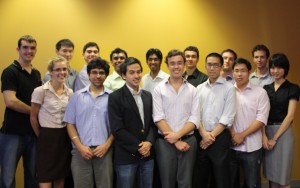The progression from university to the workforce in medicine is not comparable to any other discipline or profession.
An internship is essentially an extension of a medical degree, and the degree is redundant without one. The issue of the burgeoning numbers of Australian medical graduates, and the associated ‘crisis’ in intern placement availability, is currently the preeminent political issue for medical students. Increasingly, international students have been caught in the middle of the storm.
To put this situation in the proper context, one needs to look back to the late-1980s and 1990s. At this time, Australia was seen as being oversupplied with doctors in general. There was a strong policy reaction to this sentiment, which capped student numbers, and levied heavy restrictions on overseas-trained doctors. The turn of the century saw an abrupt turnaround in this attitude, as a different picture was painted about the country’s long-term health workforce requirements. Temporary resident visas for overseas doctors grew from 664 in 1993-1994 to 1923 in 2001-2002. [1] On the graduate front, from around 2003, government policy has allowed international medical graduates to remain in Australia. [2] Given worsening projections for future workforce shortages, one could be forgiven for thinking that this was seen as the start of a norm that would continue indefinitely. While incoming international students were never given a guarantee of placement after graduation, until recently, it was often implied that this would never be an issue.
Australia only had ten medical schools in 1999, whereas today we have twice this number. [3] International places have increased as a proportion over this time. In 2002, 161 international students graduated from Australian medical schools, representing 11% of total graduates. This year, the number is predicted to be 423 students, or 16% of the total. This is as high as 34% at one institution. [4] Unfortunately, while governments eagerly and justifiably expanded the numbers of medical places at universities, this was not matched by sufficient planning for long-term doctor training. Consequently, last year, many graduates had genuine cause for concern about receiving an intern placement. However, just because we have a bottleneck of medical graduates does not mean that we have an oversupply. Make no mistake; the future of our health system needs every single graduate we are producing. Although we are dealing with unprecedented numbers, the training system needs to come to terms with this reality as soon as possible.
Even domestic Commonwealth-supported students have had reason to worry until the Australian Health Ministers’ Conference this February, when they were given a guarantee of training places for the foreseeable future. This is to be achieved by doubling the undergraduate clinical training subsidy across all states for 2010-2011, with the annual commitment totalling $140m nationally. [5] While this is a very positive and encouraging step forward, it excludes many potential future doctors.
For international students, there are no guarantees. Worse still, some international graduates from certain Australian medical schools would not even be able to gain an internship-equivalent in their home country. One cannot underestimate the perspective of our international colleagues – after spending a fortune on living expenses and university fees, being told that they will not be able to continue their training in the country where they graduate. For some, continuing their training anywhere may be extremely difficult. This is the frightening scenario that many are now facing.
It is not a well-kept secret that many medical faculties around the country are heavily reliant on international students and their fees to fund medical programs. Can we justify milking international students for their dollars, followed by abandonment at graduation in favour of the colleagues whose degrees they subsidised? Furthermore, there is the possibility that the international student funding source could deplete if recent developments discourage new students from coming here.
Currently, governments spend enormous sums of money attracting and retraining foreign health workers. Admittedly, overseas-trained doctors are filling a more immediate gap in the system that is considerably further down the line of training than internships. This is no doubt necessary for the time being. Nonetheless, it seems senseless that we are prepared to spend such amounts bringing overseas-trained doctors into the country, but cannot bring ourselves to adequately train and retain doctors reared in our own top-class medical schools.
The ramifications extend beyond just international students. Local full-fee-paying students, who make up further 6% of medical graduates, are also excluded from the recent guarantee of training places. [6]
The challenge, of course, is not just to make places for more students, but to ensure that this does not affect the quality of teaching that all trainees receive. It is also critical that we do not simply replicate the mistakes of the past: we need to ensure that there is adequate downstream planning, not just more intern places. Recent government announcements about General Practice and specialist training places are encouraging in this regard. [7]
If governments consider international and domestic full-fee-paying students not worth retaining, then they should perhaps reconsider the approval of such medical places in the first instance. But for those already in our programs, this line of reasoning simply is not good enough. There is no adequate justification for any Australian-trained medical student being denied an intern placement. It is nonsensical to on one hand have a workforce shortage, and on the other hand be turning away the best long-term solution to that shortage. If someone is good enough to be trained in an Australian medical school, then they should be good enough to practice here.
References
[1] Hawthorne L, Birrell B. Doctor shortages and their impact on the quality of medical care in Australia. People Place 2002;10(3):55-67.
[2] Joyce CM, Stoelwinder JU, McNeil JJ, Piterman L. Riding the wave: current and emerging trends in graduates from Australian university medical schools. Med J Aust 2007; 186(6):309-12.
[3] Prideaux D. Medical education in Australia: Much has changed by what remains? Med Teach 2009;31:96-100.
[4] Medical Deans Australia and New Zealand. National Clinical Training Review: Report to the Medical Training Review Panel Clinical Training Sub-committee [Online]. 2008 Mar 26 [cited 2010 Mar 12]. Available from: URL: http://www.medicaldeans.org.au/pdf/Medical%20Deans%20National%20Clinical%20Training%20Review%20March.pdf
[5] Department of Health and Ageing. Australian Health Ministers’ Conference Communiqué [Online]. 2010 Feb 12 [cited 2010 Mar 12]. Available from: URL:http://www.health.gov.au/internet/main/publishing.nsf/Content/mr-yr10-dept-dept120210.htm
[6] Medical Deans Australia and New Zealand. Medical students may never qualify, warn Deans. [Online]. 2010 Mar 9 [cited 2010 Mar 12]. Available from: URL:http://www.medicaldeans.org.au/media_090310.html
[7] Department of Health and Ageing. Building a National Health and Hospitals Network: Training a record number of doctors [Online]. 2010 Mar 15 [cited 2010 Mar 20]. Available from: URL:http://www.health.gov.au/internet/ministers/publishing.nsf/Content/mr-yr10-nr-nr046.htm
 Significant emphasis is placed upon Evidence-Based Medicine (EBM) during medical school, resulting in student responses ranging from apathy to consternation.
Significant emphasis is placed upon Evidence-Based Medicine (EBM) during medical school, resulting in student responses ranging from apathy to consternation.




